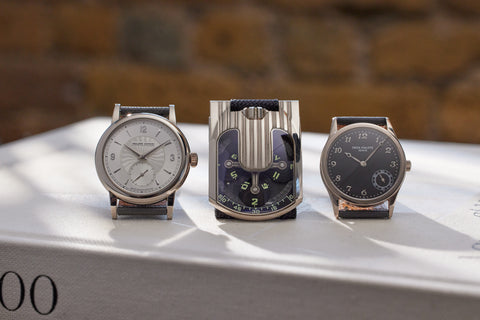Laurent Ferrier is a true independent manufacture. It is headed by Laurent Ferrier himself, who worked at Patek Philippe for 40 years, finishing as their creative director. Beyond his watchmaking pedigree, Ferrier is also notable for having raced at the 24 Hours of Le Mans, where he came third in 1979, coming behind none other than Paul Newman. Located in the village of Vernier in Switzerland, his small workshop resides in a converted single-family home, where each watch is hand-assembled by a single watchmaker.
The deep onyx dial with white Roman numerals is perhaps one of the more desirable iterations of the Tourbillon, and the dial complements the white gold case. Ferrier himself has been quoted as saying that his work focuses on delivering “simplicity, precision, and pure, uncluttered beauty”. The piece also bears Ferrier’s signature Assegai-shaped hands, a name and shape that invokes the appearance of the javelins used by Zulu warriors. Unusually, this example also comes with an additional white, two-part enamel dial, featuring black roman numerals, the “tourbillion double spiral” in a beige/gold font and subsidiary second markers in red.
Turning the watch over to reveal the movement, we see that it is powered by the FBN 916 .01, which was developed by Ferrier in conjunction with La Fabrique du Temps. This is Ferrier’s take on the double direct-impulse escapement invented by Abraham-Louis Breguet. The tourbillon is distinguished by a “double spiral”, with two spirals that are attached opposite to each other. These spirals allow it to maintain the centre of the balance firmly on its axis, and in turn, to eliminate any potential timing discrepancies. One of the earlier movement designs to emerge from the brand, it speaks to the combination of traditional watchmaking and modern reliability that the brand seeks to exhibit.
The layout of the bridges and wheels is particularly intriguing in this instance, displaying the complex movement in a way that is visually pleasing. The finishing of the movement is a major focus for the Galet Classic Tourbillon, with contrasts established between the perlage backdrop and the thick circular-grained Geneva Stripes on the bridges. The incredibly precise finishing of the interior angles is achieved using a burin, and the handwork of the manufacture’s skilled craftsmen.


















































































































































































































